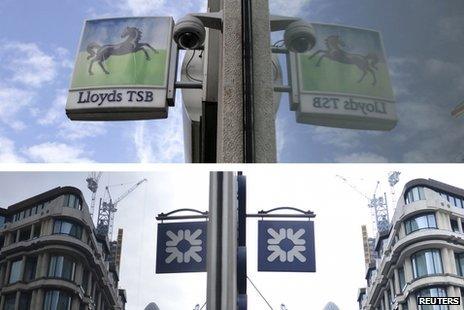UK banks need to plug £27bn capital hole, says PRA
- Published

Lloyds and RBS face the biggest shortfalls in their capital requirements
UK lenders need to raise billions more in capital to cover their risks, according to their financial regulator.
The Prudential Regulation Authority (PRA) says Britain's top banks and building societies need to fill a £27.1bn hole in their balance sheets.
Royal Bank of Scotland was the regulator's main cause of concern, accounting for £13.6bn of the total.
Lloyds Banking Group accounted for £8.6bn and Barclays £3bn. Nationwide had a shortfall of £400m.
The Co-operative Bank has already identified a £1.5bn shortfall in its finances, and announced a bond-to-equity 'bail-in' plan to deal with it.
The "capital" that these banks must raise is a measure of their ability to pass on losses to shareholders and other investors. If a bank or building society runs out of capital, then it is insolvent - meaning the value of its assets is insufficient to repay its lenders in full.
HSBC, Santander UK and Standard Chartered were given a clean bill of health by the regulator, external.
Further plans
The Bank of England's Financial Policy Committee had asked the PRA to review the state of UK banks' financial health against new guidelines agreed by international central banks.
These guidelines - known as Basel III - require banks to hold capital resources of at least 7% of their "risk-weighted assets".
The PRA concluded that, as at the end of 2012, Barclays, the Co-op, Lloyds, Nationwide and RBS "fell short of this standard".
The picture has been further complicated by the fact that two of the lenders - Barclays and Nationwide - also failed to meet a separate measure in Basel III called the "leverage ratio", and therefore must also raise further capital.
According to the BBC's Business Editor Robert Peston, the introduction of this additional requirement on a "stressed basis" - meaning after adjusting for potential losses forecast by the regulator - may have come as an unpleasant surprise for the two banks.
Five of the banks have put in place plans to fill this £27.1bn gap to the tune of £13.7bn, the PRA said, although some of their proposed measures still need regulatory approval.
The PRA expects most of the banks' remedies, which include restructurings and sell-offs, to be implemented by the end of 2013.
Even after these actions, four of the five lenders - with Nationwide the exception - will still fall short of the required standards, warns the PRA, and are required to submit further plans detailing how they will plug the £13.4bn hole that still remains.
Lloyds Banking Group in particular will have to find an additional £7bn in capital, on top of the £1.6bn it already plans.
Responding to the report, Lloyds said the bank had a "strong capital position" and that its capital adequacy ratio - known in the jargon as Basel III Core Equity Tier 1 capital ratio - would be more than 9% by the end of June, and about 10% by the end of the year.
RBS said it "continues to target" a figure of 9% by the end of 2013, while Barclays feels confident it can plug its £3bn gap through disposals.